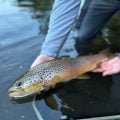Some Tips for Fishing Yellowstone National Park

Hikers and bears share the DeLacy Creek Trail | photo by Rachel Andona
First and foremost, it’s your responsibility as an angler to know and follow the fishing regulations put forth by the National Park Service. You’ll need a Yellowstone-specific fishing license, which—along with a copy of the most up-to-date regulations—is available at most fly shops in gateway communities like West Yellowstone, Gardner, Jackson and Cody. Pay close attention to opening dates, particularly in native cutthroat country—cutthroats spawn in the spring, and the National Park Service keeps many cutthroat fisheries closed, sometimes into July and August, to protect spawning cutthroats.
Also of note, as of 2018, felt-soled wading boots are no longer permitted in the park. There are worries that the felt can serve to spread aquatic invasive species, like whirling disease and New Zealand mud snails (both of which, sadly, are already found in some park waters). Remember to pay attention to updates over the course of the summer—in hot summers, many of Yellowstone’s rivers will be closed periodically to prevent stress to wild trout when rivers get too warm for their liking. Generally, when rivers reach seventy degrees, trout fishing is ceased. Water warmer than that can be deadly to trout, particularly if they’re stressed by being caught and released.
Second, remember that you’ll be fishing in the world’s first national park. This place is special to a lot of people, and four million of us visit every year. Be kind. Be considerate. Give kids the right-of-way, particularly on roadside streams where access is easy. Don’t approach wildlife—sometimes, particularly in places like the Firehole or the Lamar Valleys, you may have to move around a bit to avoid getting too close to bison.
Third, remember this little bit of advice. The farther you get from the road, the better the fishing gets. Stretch your legs. Explore. Wander a trail along a small, alpine stream or bushwhack through the willows when you can. Most folks who visit Yellowstone don’t leave sight of their vehicles (even though, for the most part, they can). Be a rogue—venture a bit into the backcountry. Chances are, you’ll be by yourself and enjoy some really good fishing for wild trout.
But be safe. Bear spray is always a good idea. Have it, and know how to use it. Your chances of encountering a bear are slim, particularly if you make noise (I always find myself whistling the tune from the old World War II film The Bridge on the River Kwai when I’m fishing in bear country) and let bears you might not see know you’re around.

A bull moose wanders the willows along the Snake River | photo by Chris Hunt
In marshy areas with willows, be on the lookout for moose. Mothers with calves can be testy—don’t get too close. The same applies, obviously, to bison, which inflict more injuries on Yellowstone tourists than any other animal.
Be aware of thermal features. Often, very hot, scalding water is located just under the crust near hot pools and hot springs. Watch where you’re walking. Carry some basic first-aid gear if you can.
Before you venture down a trail, do some simple recon. Know where you’re headed, what the trail will be like from an elevation-gain or elevation-loss perspective. Know how long it will take you to get where you’re going (and how long it’ll take to get back). Carry water (or at least water filtration equipment) and a snack or two for extended hikes. It’s always a good idea to carry a small headlamp, just in case you get delayed and you’re forced to walk out after dark.
I always like to plan my backcountry Yellowstone hikes by looking at the area I’m visiting using Google Earth or Google Maps. At the very least, consider keeping a copy of De Lorme’s Atlas and Gazetteer for Wyoming in your car. The maps or satellite images will give you enough data to be largely familiar with your destination and the difficulty of the trail you’re considering.
Finally, let someone know where you’re headed. If you don’t show up when you’re supposed to, they can at least contact officials in the park who can come looking for you.
Yellowstone is a magical place, and a lot of people love it and visit often. With all the traffic you’ll see on the roads, it may not seem like wild country. That’s an incorrect assumption. Getting off the beaten path comes with risks—as I said, most folks don’t do it. The few who do should always be prepared for the things that can go wrong.
Simply put, be smart. Don’t take unnecessary chances. If you’re wise, you’ll get to experience many great trips into the Yellowstone backcountry.
Excerpted with permission from Catching Yellowstone’s Wild Trout: A Fly-Fishing History and Guide (The History Press, June 2019, all rights reserved).












